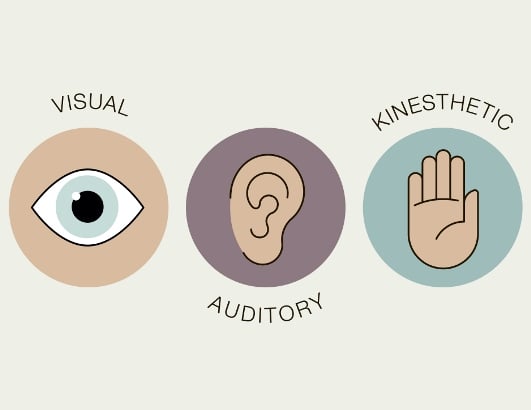People learn not only at different rates but also in different ways. Some students want their teacher or lecturers to write everything on the board. Others prefer to listen. Some like to sit in small groups and discuss a question; others like to listen to a lecture, translating it into pictures or doodles in their notebook. Such individual learning preferences are known as learning styles.
Three categories of learning styles
Learning styles are generally divided into three categories:
- (1.) visual learners, who need to see it to know it,
- (2.) auditory learners, who need to hear it to know it, and
- (3.) tactile/kinesthetic learners, who prefer a hands-on approach.
.
It goes without saying that a visual learner profits most by learning from books because his memory retains the printed words, sentences, and paragraphs. They may remember without much effort that the paragraph about the invasion of Ethiopia by Mussolini was printed on an upper left-hand page of their history book. If they go to a cinema, they will remember actions and incidents that they saw on the screen, while the spoken word becomes hazy and fades away.
In contrast, auditory learners benefit more from lectures than books since their memory retains what they pick up through the ears. They may be able to repeat a conversation almost verbatim and, at the same time, have difficulty describing what the person with whom they conducted this conversation looked like. If they attend a cinema, the sound of words and music stays with them, while the actions are soon forgotten.
Tactile/kinesthetic learners learn best by a hands-on approach. Tactile refers to touch and kinesthetic to movement, two learning modalities that are closely related. Kinesthetic learners often do well as performers: athletes, actors, or dancers.
Learning styles vs. learning principles
Once you understand your (or your child’s) learning style, you may be able to adjust your learning approach (or help your child adjust his approach) for maximum benefit. However, BEWARE! Although there is some value in adjusting to a preferred learning style, its value should not be overrated. Learning principles, which are universal, are of far greater importance than learning styles, which are individual. Learning failure will not necessarily result if one omits to adjust to a preferred learning style. However, the chances of learning success if one fails to teach or learn in accordance with learning principles are remote.
Let us compare the above situation to eating. When people eat — like when they learn — they also have individual preferences. Some people prefer to eat with their hands, some with a knife and fork, while others prefer to eat with chopsticks. Some cut their food into small chunks, while others put rather large chunks into their mouths. Some chew their food very well, while others do not allow much time for chewing.
However, the role that these individual preferences play in the eating process is relatively small. What really matters, however, is what all people have in common. All people (1.) place their food into their mouths, (2.) chew their food, and then (3.) swallow their food. Without following these three universal steps, eating would not be possible. In the same way, learning is not possible unless one follows universal learning principles.
Learning is a stratified process
The first universal learning principle is that human learning does not take place on a single level but is a stratified process.
This characteristic is worldwide accepted as a didactic principle. The way in which the school system throughout the whole world is organized is an acknowledgment of this. One cannot send a child to university first. They must start in the first class and then progress year after year to the higher levels of education. Unless they have mastered a sufficient amount of the learning material presented to them in one year to form a firm enough base on which to build the knowledge for the following year, they will not progress in the next class.
Another simple and practical example is that one has to learn to count before it becomes possible to learn to add and subtract. Suppose one tried to teach a child who had not yet learned to count to add and subtract. This would be quite impossible, and no amount of effort would ever succeed in teaching the child to add and subtract. This shows that counting is a skill that must be mastered before it becomes possible to learn to do calculations.
This means there is a sequence to be observed in learning. Certain things have to be mastered first, before it becomes possible to learn other things.
The ageless principle of repetition
A second learning principle of great importance is that learning cannot occur without repetition. There is not a single person on this earth who has learned to speak a language, swim, skate, play golf, or drive a car without repetition.
Repetition is important in the “wiring” of a person’s brain, i.e., the forming of connections or synapses between the brain cells. Without repetition, key synapses don’t form. And if such connections, once formed, are used too seldom to be strengthened and reinforced, the brain, figuring they’re dead weight, eventually “prunes” them away.
Mere repetition, however, is not the end of the story. A “pyramid of repetition” has to be constructed for the beginner learner. This means that the beginner learner must start by repeating a limited amount of material many times over and over. Gradually, less and less repetition will be necessary to master new skills and new knowledge.
Suzuki illustrates this principle in his book Nurtured by Love: A New Approach to Education:
.
.
Edublox offers cognitive training and live online tutoring to students with dyslexia, dysgraphia, dyscalculia, and other learning disabilities. Our students are in the United States, Canada, Australia, and elsewhere. Book a free consultation to discuss your child’s learning needs.
.
.
.


